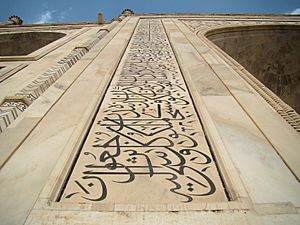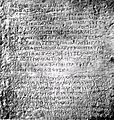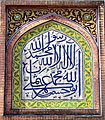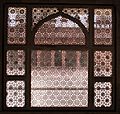Persian Inscriptions on Indian Monuments facts for kids
| Audio read by | [1] |
|---|---|
| Original title | نقش پارسی بر احجار هند |
| Illustrator | Dr.Mohammad Ajam |
| Cover artist | Dr.Ajam |
| Language | Persian -English |
| Subject | Persian Inscriptions on the Indian Monuments |
| Published | 1956-1958-2013 |
| Publisher | Tehran University . New Delhi, Tehran university |
|
Publication date
|
1956- 1958 - 2013 |
| Text | [[s:[2]|]] at Wikisource |

Persian Inscriptions on Indian Monuments is a special book written by Dr.Ali-Asghar Hekmat. It was first published in 1956 and 1958, with a new edition in 2013. This book contains the Persian words carved into stone on over 200 historical places in India. Many of these places are now famous national treasures or UNESCO World Heritage Sites.
Contents
A New Edition
After being hard to find for more than 50 years, a third edition of the book was printed. Dr. Mohammad Ajam added 200 new pictures to this version. This book is very important for students and teachers who are learning the Persian language.
What the Book is About
In India, you can often find Persian words carved into old buildings. These include mosques, tombs, forts, palaces, gateways, and even gardens or bridges. You can also find them on smaller items like seals or vases.
Most of these Persian carvings in India date back to the late 1100s AD. This was when Muhammad Ghori took over Delhi and started his rule. However, a few older carvings have been found in places like Haryana, Gujarat, and Kerala. The Persian language was used as the official court language in India for about 600 years.
Famous Palaces and Forts
The book talks about Persian inscriptions found on many important palaces and forts in India.
The Red Fort
The Red Fort is a historic fort in Delhi. It was the main home for the Mughal Emperors. Emperor Shah Jahan started building it in 1638 when he moved his capital to Delhi. The fort was originally red and white, which were Shah Jahan's favorite colors. The architect, Ustad Ahmad Lahori, also designed the Taj Mahal. The Red Fort was built between 1639 and 1648. Later, it was taken over by Nader Shah from Persia.
Rashtrapati Bhavan
The Rashtrapati Bhavan is the official home of the President of India in New Delhi. Many Persian inscriptions can be found in this large complex, especially in the Hall of Ashoka. The main building has 340 rooms, including the president's residence, guest rooms, and offices. The entire area is huge, covering 320 acres. It includes beautiful Mughal Gardens, open spaces, and homes for staff. It is the largest residence for any head of state in the world.
Important Tombs
The book describes 47 different tombs and mausoleums in India that have Persian inscriptions.
Akbar's Tomb
The Mausoleum of Akbar, also known as Akbar's tomb, is the resting place of the Mughal emperor Akbar. This tomb is a very important historical site. It was built between 1605 and 1613 by Akbar's son, Jahangir. It is located in Sikandra, near Agra. The tomb is made of beautiful marble stone with Persian inscriptions and poems carved into it.
Persian Inscriptions in Mosques
The book also describes Persian inscriptions found in 14 mosques across India.
Jama Masjid, Delhi
The Jama Masjid, Delhi is one of the largest mosques in India. It was built by the Mughal Emperor Shah Jahan between 1650 and 1656. The mosque was finished in 1656 AD. It has three large gates and two tall minarets, which are 40 meters high. These are made of red sandstone and white marble. The main courtyard can hold over 25,000 people. There are three domes on the roof, surrounded by the two minarets. The design of the Badshahi Masjid in Lahore, built by Shah Jahan's son Aurangzeb, is very similar to the Jama Masjid. Shah Jahan also built the Taj Mahal in Agra and the Red Fort in Old Delhi. The Jama Masjid remained the main royal mosque for the emperors until the end of the Mughal period.
Gallery
Here are some pictures of important places in India that have Persian inscriptions. These places are explained in the book. You can find more pictures on Flickr [3].
-
Hazratbal Shrine in Kashmir, srinagar.
-
Persian poem on the palace of Agra.
Related pages
- Tomb of Akbar the Great
- Red Fort
- Fatehpur Sikri
- Taj Mahal
- Lucknow
- Persian
- Persian language
- calligraphy
- Documents on the Persian Gulf's name
- Persian language In India
- List of World Heritage Sites in Western Asia
- books
- art
- painting
- History of Iran
- History of India
- architecture
- persian
More Information
- Persian Inscriptions on Indian heritage Monuments by Dr. Ajam.
- The systematic survey and study of Perso-Arabic epigraphy of the Indian [4]
- Archaeological Survey of India [5]
- Free Download and save the old text of the book published in Persian 1958: [6]
- Voice book of Persian Inscriptions on Indian Monuments [7]
- Iranian Influence On Medieval Indian Architecture. by S.A. Rezvi. [8]
- Persian Inscriptions on Indian Monuments [9]
- SOME PHOTO OF THE BOOK IN FLIKER [[10]]
- Catalogue of Persian Manuscripts in the Library of the India Office [11]
Images for kids
-
Badshahi Masjid, Lahore, Pakistan, was once the largest mosque in the world.
-
Qutub Minar, a famous example of Islamic architecture in India.
-
Circumferential Gallery around the cenotaph.
-
The Taj Mahal.
-
Rashtrapati Bhavan, the Indian presidential palace.
-
The Jama Masjid in Old Delhi.
-
Humayun’s Tomb, Delhi, India.
-
Jahangir's grave at the Tomb of Jahangir, decorated with parchin kari work.
-
Tomb of Nithar Begum at Khusro Bagh, Allahabad.
-
At 72.5m tall, the 13th-century Qutub Minar is the world's tallest brick minaret.
-
The Red Fort and Independence Day.
-
Qutbuddin Bakhtiar Kaki's dargah in Mehrauli, Delhi.
-
The dargah of Moinuddin Chishti, Ajmer.
-
The Nizamuddin Dargah in Delhi.
-
The Tomb of Salim Chisti at Fatehpur Sikri near Agra.
-
Humayun's Tomb was a model for Taj Mahal.
























































































